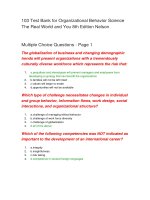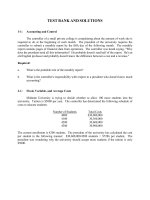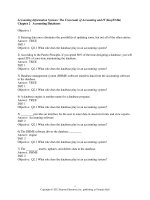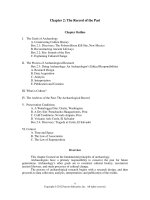Managing organizational behavior what great managers know and do 2nd edition baldwin test bank
Bạn đang xem bản rút gọn của tài liệu. Xem và tải ngay bản đầy đủ của tài liệu tại đây (353.57 KB, 92 trang )
Chapter 02
Managing Stress and Time
True / False Questions
1. Strains are more long-term consequences of chronic stress that have not been
alleviated by some means.
True
False
2. All stress is bad.
True
False
3. Good time management means being an efficient workaholic.
True
False
4. Stress can and does facilitate higher performance and productivity.
True
False
5. Great managers are aware of different sources of stress and seek ways to
proactively manage it to avoid its harmful effects.
True
False
6. Stressful events by themselves generate stress in individuals.
True
False
7. Different stressors call for different coping strategies.
True
False
8. In general, having an external locus of control is more beneficial than having an
internal locus of control with regard to job performance and stress.
True
False
9. People tend to underestimate how much large events in their lives contribute to
their stress level and grossly overestimate the effects of "daily hassles."
True
False
10. When we do not know how to fill a role or what we are supposed to do in it, we
experience role conflict.
True
False
11. Age is one of the strongest demographic predictors of burnout with older
employees experiencing significantly greater burnout than younger employees.
True
False
12. Research has shown that with respect to burnout, the only gender differences
seem to be that men experience more emotional exhaustion symptoms, while
women experience slightly more cynicism symptoms.
True
False
13. Emotional labor is the process of regulating both feelings and expressions for the
benefit of organizational goals.
True
False
14. Deep acting is "managing observable expressions" such as maintaining a pleasant
facial expression and vocal tone.
True
False
15. Coping strategies are "first line" defenses for managing stress.
True
False
16. Coping strategies are not always practical because it is not possible to remove
every stressor from the work environment.
True
False
17. Instrumental support is support that is tangible and practical in nature and is a
direct means of helping someone.
True
False
18. Appraisal support is feedback that builds your self-esteem.
True
False
19. One of the antidotes for choking is pressure-free practice.
True
False
20. What makes choking so fascinating is that it happens only to star performers.
True
False
21. Focused automated behavior is one of the antidotes for choking.
True
False
22. Research has helped identify four recurring factors that distinguish those with
psychological hardiness: psychological fitness, physical fitness, control, and
challenge.
True
False
23. When under intense stress, we naturally ask for help from our network of family
and friends.
True
False
24. One stress-management strategy closely aligned with control is that of seeking
big achievements.
True
False
25. Psychologically hardy individuals view change as a stumbling block, not a stepping
stone.
True
False
26. The inability to manage time is among the greatest sources of stress and can
doom the most conscientious of people.
True
False
27. As management guru Peter Drucker has famously noted, doing things right
should come before doing the right things.
True
False
28. Often referred to as Pareto's Law, the 80/20 rule holds that only 20 percent of the
work produces 80 percent of the value.
True
False
29. What you choose not to do can be as important as what you do.
True
False
30. The ABC method is a strategy used to address procrastination.
True
False
Multiple Choice Questions
31. Which of the following observations about strains is true?
A. Strain is defined as a controlled or nonproductive stress.
B. Strain occurs when people are experiencing both high work demands and high
control over the task.
C. Strain is a personal, non-work issue and should not be a concern in a work
organization.
D. Strains are often more long-term consequences of chronic stress that have not
been alleviated.
E. There is no clear evidence of the impact of sustained stress in strains.
32. Which of the following is NOT a likely behavior for a manager experiencing high
levels of stress?
A. Underestimation of how fast time passes
B. Selective information perception
C. Fixation on single solutions to problems
D. Reversion to old habits for problem solving
E. Decreased creativity
33. Which of the following is NOT a common stress-related physical problem?
A. Heart disease
B. Stroke
C. Depression
D. Diabetes
E. Cancer
34. "Eustress" is defined as:
A. maximum psychological pressure.
B. a productive stress.
C. an autoimmune response.
D. a response to uncertain conditions.
E. a response pattern to perceived threat.
35. When people encounter something potentially stressful in the environment, they
first go through:
A. cognitive responses.
B. primary appraisal.
C. physiological responses.
D. coping strategies.
E. denial.
36. Current research shows that one specific aspect of the Type A behavior pattern is
most predictive of one's health. Identify that aspect.
A. Hostility
B. Time urgency
C. Ambitiousness
D. Impatience
E. Perfectionism
37. Which of the following is experienced when in fulfilling a family role, a work role is
neglected?
A. Psychological hardiness
B. Locus of control
C. Eustress
D. FIW
E. WIF
38. Why do organizations often make accommodations for large stressful events?
A. These events occur infrequently.
B. Most individuals expect these events.
C. These events are not accepted as a source of trauma.
D. The role of these events as stressors is overestimated.
E. Families and friends help with these events.
39. Which of the following is an example of a "traumatic/major event" type of stress?
A. Losing all access to work files because of a computer crash.
B. Starting on a new job that requires substantial training.
C. Receiving an e-mail that requires an immediate response.
D. Having an unexpected visitor drop in.
E. Unexpected and urgent phone calls from a client.
40. Depersonalization is associated with:
A. the feeling that one's work does not really matter.
B. feeling cynical, psychologically detached, and indifferent to one's work.
C. the state of feeling psychologically "drained" by the job.
D. the actual management of feelings.
E. giving employees some latitude over the emotions they can express.
41. Surface acting and deep acting are parts of:
A. burnout.
B. role conflict.
C. emotional labor.
D. role ambiguity.
E. locus of control.
42. ___________ is defined as performance decrements under pressure circumstances.
A. Choking
B. Loss of control
C. Burnout
D. Emotional labor
E. Fraying
43. The tendency of people under stress to focus on the threat to the exclusion of all
else is a well-established process called:
A. "tunnel vision."
B. "stress focusing."
C. "focused coping."
D. "concentrated appraisal."
E. "cognitive narrowing."
44. Employees who have ________________ exhibit better mental performance, greater
ability to cope with stress, lower obesity levels, and higher energy levels.
A. role conflict
B. psychological strength
C. physical hardiness
D. many daily hassles
E. good time management skills
45. Which of the following activities CANNOT be classified as a mood "repair"
activity?
A. Imagine being on vacation
B. Do deep breathing exercises
C. Listen to a piece of music
D. Have a piece of chocolate
E. Talk to a friend
46. The most important challenge in effective time management is to:
A. exercise willpower.
B. implement time management skills.
C. resist temptation.
D. evaluate plan options.
E. learn time management skills.
47. Nollie always misses the deadline for her quarterly report. She works diligently and
sincerely makes "to-do lists." Nevertheless, she ends up spending most of her time
on whatever comes up, is urgent, or is in front of her. Which time management
principle does Nollie need to master?
A. First be effective, then be efficient
B. Multitasking
C. Follow the five-second rule
D. Exercise willpower
E. Start earlier in the morning
48. Duffy Smith started having nightmares and chest pains and losing car keys and
theater tickets. His wife urged him: "Take a vacation. See a physician. Do
something!" So Duffy went to work on a Sunday afternoon. He threw out old files
and glanced at the stack of weekly work logs accumulating next to the rubber tree
plant. He sat down to eat the pizza he had ordered and looked at the work logs
again. Then he retrieved the rest of them for a thorough study. Over the last
quarter, the time spent on paperwork and reporting tasks had grown from 20
percent to 80 percent. He usually began to prepare the item status and inquiry
report on Monday. Co-workers delivered rumors, management changed weekly
priorities three or four times during the week, and balance estimates fluctuated
constantly. So Duffy revised the report daily through the week until submitting it
to management on Friday afternoon. The productive work of outside client
contacts, which used to account for most of his time, was now squeezed into long
lunches. Duffy decided to make some changes and left the building feeling better
than he had in months. He told his wife, "If my new work plan works next quarter,
we'll go to Calgary for a week in July." He started to prepare the item status and
inquiry report on Thursday mornings, turning it in by noon on Friday. He
scheduled contact meetings a week or two in advance, doing preparation work by
phone and e-mail to increase client contact value. He followed up earlier and
more thoroughly with each client. Duffy quickly returned to his old patterns of
peaceful sleep and feeling good. Tomorrow Duffy and his wife go to Canada.
Please answer the following question based on this scenario.
Which time management principle does Duffy's work revision illustrate?
A. To increase motivation, do the fun part first.
B. Start with written goals and action plans.
C. Use the Swiss Cheese approach effectively.
D. When work is out of sight, it is out of mind.
E. Spend the bulk of time on the most important work.
49. Duffy Smith started having nightmares and chest pains and losing car keys and
theater tickets. His wife urged him: "Take a vacation. See a physician. Do
something!" So Duffy went to work on a Sunday afternoon. He threw out old files
and glanced at the stack of weekly work logs accumulating next to the rubber tree
plant. He sat down to eat the pizza he had ordered and looked at the work logs
again. Then he retrieved the rest of them for a thorough study. Over the last
quarter, the time spent on paperwork and reporting tasks had grown from 20
percent to 80 percent. He usually began to prepare the item status and inquiry
report on Monday. Co-workers delivered rumors, management changed weekly
priorities three or four times during the week, and balance estimates fluctuated
constantly. So Duffy revised the report daily through the week until submitting it
to management on Friday afternoon. The productive work of outside client
contacts, which used to account for most of his time, was now squeezed into long
lunches. Duffy decided to make some changes and left the building feeling better
than he had in months. He told his wife, "If my new work plan works next quarter,
we'll go to Calgary for a week in July." He started to prepare the item status and
inquiry report on Thursday mornings, turning it in by noon on Friday. He
scheduled contact meetings a week or two in advance, doing preparation work by
phone and e-mail to increase client contact value. He followed up earlier and
more thoroughly with each client. Duffy quickly returned to his old patterns of
peaceful sleep and feeling good. Tomorrow Duffy and his wife go to Canada.
Please answer the following question based on this scenario.
Duffy's stress source at the start of the scenario was:
A. daily hassles.
B. big events.
C. family pressures.
D. daily uplifts.
E. eustress.
50. Duffy Smith started having nightmares and chest pains and losing car keys and
theater tickets. His wife urged him: "Take a vacation. See a physician. Do
something!" So Duffy went to work on a Sunday afternoon. He threw out old files
and glanced at the stack of weekly work logs accumulating next to the rubber tree
plant. He sat down to eat the pizza he had ordered and looked at the work logs
again. Then he retrieved the rest of them for a thorough study. Over the last
quarter, the time spent on paperwork and reporting tasks had grown from 20
percent to 80 percent. He usually began to prepare the item status and inquiry
report on Monday. Co-workers delivered rumors, management changed weekly
priorities three or four times during the week, and balance estimates fluctuated
constantly. So Duffy revised the report daily through the week until submitting it
to management on Friday afternoon. The productive work of outside client
contacts, which used to account for most of his time, was now squeezed into long
lunches. Duffy decided to make some changes and left the building feeling better
than he had in months. He told his wife, "If my new work plan works next quarter,
we'll go to Calgary for a week in July." He started to prepare the item status and
inquiry report on Thursday mornings, turning it in by noon on Friday. He
scheduled contact meetings a week or two in advance, doing preparation work by
phone and e-mail to increase client contact value. He followed up earlier and
more thoroughly with each client. Duffy quickly returned to his old patterns of
peaceful sleep and feeling good. Tomorrow Duffy and his wife go to Canada.
Please answer the following question based on this scenario.
Duffy's stress symptoms were:
A. subtle.
B. familial.
C. eustresses.
D. physiological.
E. hardy.
51. Which of the following is often referred to as Pareto's Law?
A. The 80/20 rule
B. The Swiss Cheese Method
C. The ABC method
D. The five-second rule
E. The two-minute rule
52. Relationship building falls under the _____ quadrant in a time management matrix.
A. relevant/urgent
B. important/not urgent
C. important/urgent
D. not important/urgent
E. not important/not urgent
53. Interruptions fall under the _____ quadrant in a time management matrix.
A. relevant/not urgent
B. important/not urgent
C. important/urgent
D. not important/urgent
E. not important/not urgent
54. Trivia falls under the _____ quadrant in a time management matrix.
A. relevant/not urgent
B. important/not urgent
C. important/urgent
D. not important/urgent
E. not important/not urgent
55. Which of the following is a specific time management suggestion?
A. Taking a break
B. Lengthening workday
C. Multitasking
D. Working on weekends
E. Checking e-mail in the morning
56. The task of _____ should be performed during external prime time.
A. writing a letter
B. long-range planning
C. having a team meeting on an important project
D. attending recreational programs
E. analyzing the budget
57. Which of the following time management strategies is an "instant task" related
to?
A. The 80/20 rule
B. The Swiss Cheese Method
C. The ABC method
D. The next action
E. The two-minute rule
58. The Swiss Cheese Method is suggested to fight:
A. procrastination.
B. busywork.
C. boredom.
D. isolation.
E. harassment.
59. "Do it now if you are ever going to do it at all" is an application of the _____ time
management technique.
A. Swiss Cheese
B. two-minute rule
C. ABC
D. matrix management
E. prime internal goal monitor
60. The TRAF system is used to:
A. run staff meetings.
B. organize paper and e-mail.
C. evaluate peer feedback on assessment instruments.
D. schedule personal fitness activities.
E. balance life and work demands.
Essay Questions
61. What is stress and how is it different from strain?
62. Identify some common myths about stress and time management.
63. Your friend Alice has an important exam coming up. She desperately needs to
score high in this exam. She is experiencing extreme stress. She concludes that all
stress is bad. Do you agree with her? Elaborate.
64. All stressors are not created equal. Give three examples of sources of stress
(stressors) for yourself. Now list out top three stressors for the person you know
best apart from yourself (could be a friend, parent, or sibling). Do these two lists
match?
65. Describe the major components to the stress process.
66. Henry, a top sales executive at Personalized Inc., a personal care product
company, is described around his workplace as a Type A individual. What are the
characteristics of a Type A individual?









